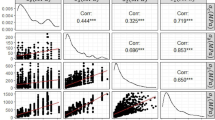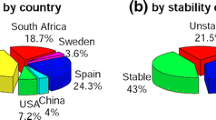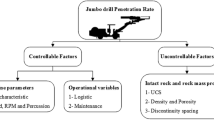Abstract
This paper presents a machine learning (ML)-based method for predicting the end-bearing capacity of rock-socketed shafts. For ML model training and testing, a database of 151 test shafts covering a wide range of rock types, shaft dimensions, and ground profiles has been developed from various sources. To properly take into account different factors, the rock property constant \({m}_{i}\), unconfined compressive strength of intact rock \({\sigma }_{c}\) (MPa), geological strength index GSI, length of the shaft within the soil layer \({H}_{s}\) (m), length of the shaft within the rock layer \({H}_{r}\) (m), and shaft diameter \(B\) (m) were taken as the inputs and the ultimate bearing capacity factor \({N}_{\sigma }\), which is the ratio of ultimate end-bearing capacity to \({\sigma }_{c}\), was taken as the target output. Four commonly used ML algorithms, support vector machine (SVM), decision trees (DT), random forest (RF), and Gaussian process regression (GPR), were first utilized to train models, respectively. Then, the trained models with the four ML algorithms were fused together with an ensemble learning (EL) approach to further enhance the prediction accuracy. Comparisons with existing empirical equations show a much better performance of the ML-based method for predicting the end-bearing capacity of rock-socketed shafts. Parametric studies were also performed with the EL model to investigate the importance of the six input parameters and the results show that the most important parameter is \({\sigma }_{c}\), followed by B, GSI, \({H}_{r}\), \({H}_{s}\) and \({m}_{i}\) in the order of importance. For the convenient application of the ML-based method, a graphical user interface (GUI) app has been developed. Finally, two examples were analyzed to demonstrate the application of the GUI app with the implemented EL models. The results show that the GUI app can be used for quick and accurate prediction of the end-bearing capacity of rock-socketed shafts by considering the various parameters.
Highlights
-
Four machine learning algorithms are fused together with an ensemble learning approach to predict the ultimate bearing capacity of rock socketed shafts.
-
The proposed ensemble learning model outperforms other existing empirical methods.
-
For the convenient application of the ensemble learning-based method, a graphical user interface app has been developed.











Similar content being viewed by others
References
Abu-Hejleh N, O’Neill MW, Hanneman D and Atwooll WJ (2003) Improvement of the geotechnical axial design methodology for Colorado’s drilled shafts socketed in weak rocks. Colorado Department of Transportation, Research Branch, Denver, Colo. Report CDOT-DTD-R-2003-6. https://www.codot.gov/programs/research/pdfs/2003/axialdesign.pdf/
Argema (1992) Design guides for offshore structures: offshore pile design. In: Tirant PL (ed) Association de Recherche en Geotechnique Marine. Editions Technip, Paris
Armaghani DJ, Raja Shoib RSNS, Faizi K, Rashid ASA (2017) Developing a hybrid PSO–ANN model for estimating the ultimate bearing capacity of rock-socketed piles. Neural Comput Appl 28:391–405
ASSHTO (1996) Standard specifications for highway bridges, 16th edn. American Association of Stata Highway and Transportation Officials, Washington
Boucheloukh A, Gong W, Dai G (2014) Prediction of the base resistance for drilled shafts socketed into rock. Rock Mech Appl Civ Min Petrol Eng. https://doi.org/10.1061/9780784413395.017
CGS (1985) Canadian foundation engineering manual, 2nd edn. Canadian Geotechnical Society, Toronto
Coates DF (1967) Rock mechanics principles. Queen’s printer, Ottawa, Canada
Crapps DK, and Schmertmann JH (2002) Compression top load reaching shaft bottom—Theory versus tests. In: O'Neill MW, Townsend FC (ed) Geotechnical Special Publication 116, Deep Foundations 2002: An International Perspective on Theory, Design, Construction, and Performance. American Society of Civil Engineers, Reston, VA, pp 1533-1549. https://doi.org/10.1061/40601(256)109
Galindo RA, Serrano A, Olalla C (2017) Ultimate bearing capacity of rock masses based on modified Mohr-Coulomb strength criterion. Int J Rock Mech Min Sci 93:215–225
Gharsallaoui H, Jafari M, Holeyman A (2020) Pile end bearing capacity in rock mass using cavity expansion theory. J Rock Mech Geotech Eng 12:1103–1111
Hashemi M, Moghaddas S, Ajalloeian R (2010) Application of rock mass characterization for determining the mechanical properties of rock mass: a comparative study. Rock Mech Rock Eng 43:305–320. https://doi.org/10.1007/s00603-009-0048-y
Hoek E, Brown ET (1997) Practical estimates of rock mass strength. Int J Rock Mech Min Sci Geomech Abstr 34:1165–1186
Kulkarni RU, Dewaikar DM (2017) An empirical approach to assess socket friction and point resistance of axially loaded rock-socketed piles of Mumbai region. Int J Geotech Eng 11(5):479–486. https://doi.org/10.1080/19386362.2016.1237607
Leung CF, Ko HY (1993) Centrifuge model study of piles socketed in soft rock. Soils Found 33(3):80–91
Nocedal J, Wright SJ (2006) Numerical optimization. Springer, New York
O’Neill MW, Reese LC (1999) Drilled shafts: construction procedures and design methods. Department of Transportation, Federal Highway Administration (FHWA), office Implementation, Mclean, VA. FHWA Publication No. FHWA-IF-99-025. https://www.fhwa.dot.gov/engineering/geotech/foundations/nhi10016/nhi10016.pdf
Poulos HG, Davis EH (1980) Pile Foundation Analysis and Design. John Wiley and Sons, New York, NY
Perrone MP, Cooper LN (1992) When networks disagree: ensemble methods for hybrid neural networks
Rowe RK, Armitage HH (1987) A design method for drilled piers in soft rock. Can Geotech J 24(1):126–142
Sadrossadat E, Ghorbani B, Oskooei R, Kaboutari M (2018) Use of adaptive neuro-fuzzy inference system and gene expression programming methods for estimation of the bearing capacity of rock foundations. Eng Comput 35(5):2078–2106
Serrano A, Olalla C (2002) Ultimate bearing capacity at the tip of a pile in rock—part 1: theory. Int J Rock Mech Min Sci 39(7):833–846
Serrano A, Olalla C, Galindo RA (2014) Ultimate bearing capacity at the tip of a pile in rock based on the modified Hoek-Brown criterion. Int J Rock Mech Min Sci 71(7):83–90
Shahin MA (2010) Intelligent computing for modeling axial capacity of pile foundations. Can Geotech J 47:230–243
Tajeri S, Sadrossadat E, Bazaz JB (2015) Indirect estimation of the ultimate bearing capacity of shallow foundations resting on rock masses. Int J Rock Mech Min Sci 80:107–117
Vapnik V (1995) The nature of statistical learning theory. Springer, New York
Vesic AS (1973) On penetration resistance and bearing capacity of piles in sand. In: Proceedings of the 8th international conference on soil mechanics and foundation engineering, Moscow, pp 78–81
Vipulanandan C, Hussain A, and Usluogulari O (2007) Parametric study of open core-hole on the behavior of drilled shafts socketed in soft rock. In: Camp W et al. (ed) Geotechnical Special Publication No. 158, Proc. Of Geo-Denver 2007: Contemporary Issues in Deep Foundations. American Society of Civil Engineers, Reston, VA. https://doi.org/10.1061/40902(221)6
Yasufuku N, Hyde AFL (1995) Pile end-bearing capacity in crushable sands. Géotechnique 45(4):663–676
Zhang L (2004) Drilled shafts in rock: analysis and design. Balkema, London
Zhang L (2010) Prediction of end-bearing capacity of rock socketed shafts considering rock quality designation (RQD). Can Geotech J 47:1071–1084
Zhang L, Einstein H (1998) End bearing capacity of drilled shafts in rock. J Geotech Geoenv Eng 124(7):574–584
Zhang C, Lim P, Qin A, Tan K (2017) Multiobjective deep belief networks ensemble for remaining useful life estimation in prognostics. IEEE Rrans Neurak Netw Learn Syst 28(10):2306–2318
Zhang Q, Huang XB, Zhu HH, Li JC (2019) Quantitative assessments of the correlations between rock mass rating (RMR) and geological strength index (GSI). Tunn Undergr Space Technol 83:73–81
Ziaee SA, Sadrossadat E, Alavi AH, Shadmehri DM (2015) Explicit formulation of bearing capacity of shallow foundations on rock masses using artificial neural networks: application and supplementary studies. Environ Earth Sci 73(7):3417–3431
Author information
Authors and Affiliations
Corresponding author
Additional information
Publisher's Note
Springer Nature remains neutral with regard to jurisdictional claims in published maps and institutional affiliations.
Supplementary Information
Below is the link to the electronic supplementary material.
Rights and permissions
About this article
Cite this article
Chen, H., Zhang, L. A Machine Learning-Based Method for Predicting End-Bearing Capacity of Rock-Socketed Shafts. Rock Mech Rock Eng 55, 1743–1757 (2022). https://doi.org/10.1007/s00603-021-02757-9
Received:
Accepted:
Published:
Issue Date:
DOI: https://doi.org/10.1007/s00603-021-02757-9




